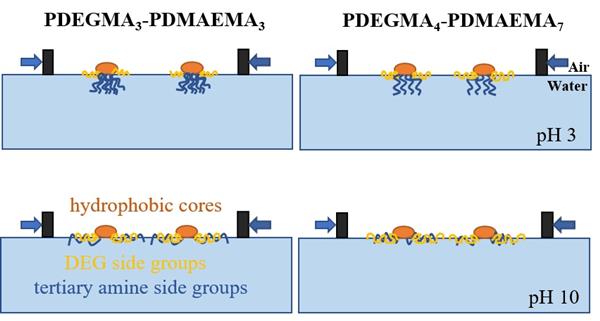34.【Langmuir】Closely Packed Core-Shell Micelle Structures of Double Hydrophilic Mikto-Arm Star Copolymers at the Air/Water Interface
writer:Yu Zhang, Gangyao Wen,* Despoina Giaouzi, Stergios Pispas, Jian Li
keywords:LB film, star copolymer, Langmuir monolayer, subphase condition, double hydrophilicity
source:期刊
specific source:Langmuir, 2024, 40(15), 8284–8290.
Issue time:2024年
The aggregation behavior of amphiphilic block copolymers at the air/water interface has been extensively studied, but less attention was given to that of star copolymers. In this work, we studied the interfacial aggregation behavior of two double hydrophilic pH- and temperature-responsive mikto-arm star copolymers of poly[di(ethylene glycol) methyl ether methacrylate]-poly[2-(dimethylamino)ethyl methacrylate] (PDEGMA3-PDMAEMA3 and PDEGMA4-PDMAEMA7, the subscripts denote arm numbers) with different molecular weights. The effects of subphase pH and temperature on the monolayer isotherms and hysteresis curves of the two star copolymers and the morphologies of their Langmuir-Blodgett (LB) films were studied by the Langmuir film balance technique and atomic force microscopy, respectively. At the air/water interface, the two star copolymers tend to form closely packed micelles. These micelles exhibit a core-shell structure, where the small hydrophobic core consists of crosslinker of ethylene glycol dimethacrylate (EGDMA) and the carbon backbones of PDEGMA and PDMAEMA arms, and the short hydrophilic shell is composed of di(ethylene glycol) and tertiary amine side groups. With increasing subphase pH, the surface pressure versus molecular area isotherms shift toward larger mean molecular areas as a result of the enhanced interface-adsorption of non-protonated tertiary amine groups. The isotherm shift of PDEGMA3-PDMAEMA3 monolayers is primarily attributed to high density of tertiary amine groups in the shells, while that of PDEGMA4-PDMAEMA7 is mainly attributed to high density of di(ethylene glycol) groups in the shells. The hysteresis degrees in the monolayers of the two copolymers under alkaline and neutral conditions are greater than those under acidic conditions due to the decreased protonation degree of tertiary amine groups. At 10 oC, the mobility of the shells is poor, and the isotherms are located on the right. Above the lower critical solution temperature, di(ethylene glycol) groups contract, which causes a slight shift of the isotherms towards smaller mean molecular areas.

Article address: https://doi.org/10.1021/acs.langmuir.4c00437